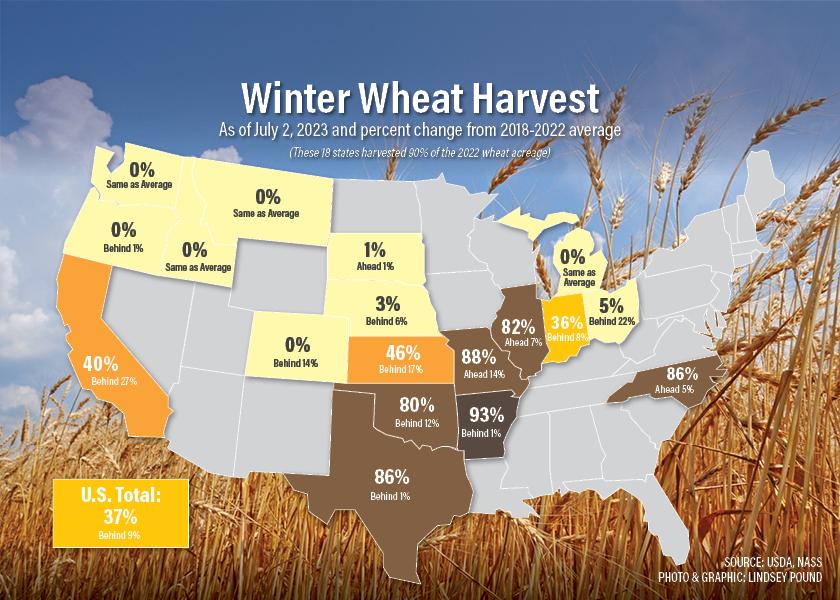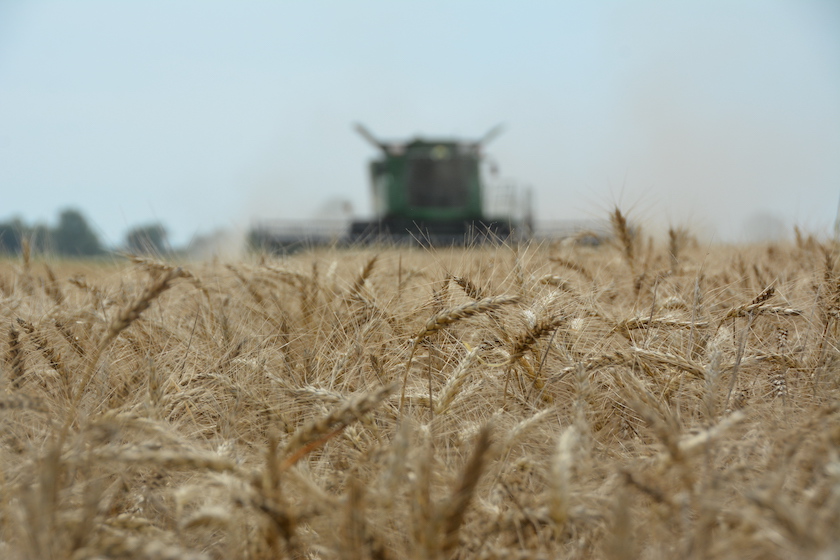A Tale of Two Wheat Harvest Extremes is Now Playing Out in the Nation's Breadbasket

The rhythm of wheat harvest is a symbolic sight during the summer months. This year, the sounds of harvest are rather quiet in some of the biggest wheat producing areas of the country, as extreme drought turned into a deluge of rain. While farmers in those areas are faced with a difficult decision, possibly walking away and not harvesting some fields this year, other farmers in eastern Kansas and Missouri are seeing harvest happen at a historic pace.
For eastern Kansas farmer Adam Phelon, wheat harvest started at a pace he had never seen.
“This the earliest we've harvested wheat that I can remember,” says Phelon who farms in Melvern, Kan. “We've been able to get in the field at least three to four weeks earlier than we would have on a typical year.”
Last year, the Phelons didn’t even start harvest until mid-July. This year, harvest is nearly wrapped up by that time.
“It's because of these dry conditions that we've been able to get in so much earlier,” says Phelon.
With cracks in the ground and visible stress to the crops, signs of drought are hard to miss. Even with the dryness, he says wheat yields on his farm are surprisingly good.
“We had pretty decent rains earlier in the spring that really helped help the wheat and tiller and grow,” says Phelon. “So the yields have been in the mid-50s to lower 60s throughout our area, and that's pretty good.”
The yields farmers are seeing in his pocket of eastern Kansas are also a big difference from 2022.
“Last year's yields were a little bit lower,” says Phelon. “They were in the 40s, so we've been pretty pleased with what we've seen.”
Winter Wheat Troubles in Central and Western Kansas
While yields are strong in eastern Kansas, the area only accounts for 10% of the state’s total wheat production. The majority of wheat production in the state is farther west and south, areas of the state that are seeing a more challenging harvest this year.
“Harvest is progressing really slow,” says Justin Gilpin, CEO of Kansas Wheat. “It is turning into quite the slugfest to get things finished out.”
Farmers located in the heart of the wheat production areas of Kansas suffered through drought for consecutive years. Prospects for the crop were already down, with some areas half or even 25% of what they would normally harvest. Now, the rains won't shut off.
“It's frustrating, probably is the best way to describe it, because of the rains that came late that we really needed back in March and April for this crop to benefit from are coming in now, creating some challenges,” he says.
Related News: Wheat Tour Finds Drought, Freeze Robbed More Wheat Than Expected, Surprisingly High Abandonment Now Pegged Across Kansas
The Kansas Wheat Tour exposed drought’s impact on the crop in May, especially in the central corridor of the state.
“Those are drought-stricken areas where we had thin, short wheat, that the yields were between 10 and 25 bushels per acre. And what farmers are having to deal with now, is because of the rain and the lack of canopy, the weed pressure that's really come on where you have weeds that are actually taller than some of the low-yielding wheat that's out there,” he explains.
Farmers Fear They Won't Finish Wheat Harvest
With weeds overgrowing the wheat, and relentless rains continuing to fall, farmers fear they may not even get to finish wheat harvest this year.
“Low lying areas in those fields, where you do have some mud puddles that they're having to go around, that maybe only half of the field is going to end up getting harvested, and maybe some of it not be harvested at all,” says Gilpin.
The wheat tour in May projected abandonment at 19% in Kansas. The high number was from scars of the drought, as well as the cold weather. Now, Gilpin thinks that figure could grow as rains prevent harvest from even happening.
“Abandonment is extremely high, maybe the highest we've had in over 20 years for the state of Kansas, and I do think it probably is going to climb a little bit more because of the challenges with the with rain and the weed pressure,” says Gilpin.
This past weekend, farmers in Kansas were dealt with another blow, this time in the form of hail. Photos and videos on Twitter showed the dramatic impact it had on some of the areas with strong crop prospects. The crop was wiped out in a matter of minutes.
Well…it happened…2 days from running wide open on wheat harvest and some of the best yields in the state…gone…corn gone also…not fun driving around. But the sun will come up tomorrow.. we will persevere. pic.twitter.com/s1Tyvq8CPa — Keaton Frewen (@FrewenK) July 9, 2023
Harvest Progress Numbers from USDA
USDA’s Crop Progress report last week showed statewide, Kansas farmers are running 17 percentage points behind average when it comes to harvest. The state is a whopping 34 points behind last year.
To the east, Missouri farmers are nearing the finish line with 88% of the state’s winter wheat crop harvested, which is 14 points ahead of normal.
Missouri Farmers See Rapid Winter Wheat Harvest Pace
The rapid planting pace is a storyline across Missouri farms, and it’s largely due to the drought impacting the majority of the state.
Jeff Nail of Nail Farms is in Orrick, Mo, and harvest for his family's farm is already wrapped up.
“Last time we planted wheat was probably six years ago.” Says Nail.

Just like other farmers across the Midwest, the Nails decided to give wheat a try again this year for two main reasons.
“We thought the summer income is nice, and the price was pretty attractive, as well,” says Nail.
Bountiful Crop Despite Drought
Since it had been so long since their farm grew wheat, only about 10% of their acres were covered in wheat this winter, a decision that’s paying off on the good ground
“Yields on the good dirt, the heavy dirt, have been really good,” says Nail. “The lighter soil has struggled. We were dry at a crucial time, and lighter soil really struggled this year.”
Nail says 60 bu. per acre to 70 bu. per acre yields are considered good in his area.
“We did have some wheat that was running at 90 bushel on the good dirt, but on lighter dirt, 30 to 40 was catching most of that,” he adds.

Just across the road, wheat is a staple for neighboring farmer Tom Waters.
“I like to grow wheat, I like cutting wheat,” says Waters. “Wheat has kind of a bad reputation in our area, a lot of people moved away from it and don't like to plant it, but I still like to plant it. I fertilize the heck out of it and just figure some of that fertilizer is good for the beans, too.”
Related Story: Blank Space to Work of Art, Missouri Wheat Field Transitions into Unique Welcome to Taylor Swift
With a heavy dose of fertilizer across their winter wheat, it’s showing up in the yields they’re seeing this year.
“I think this fields probably going to be between 80 and 90 bushels [per acre],” says Waters. “So, you can't complain about that, for sure, especially the weather we've been having.”
The yields are a bit of surprise considering how dry it’s been all winter in Missouri, but it’s also prompting wheat harvest to see an earlier start and finish.
The dryness and triple digit heat last week are sprouting concerns about the summer crops, especially with the corn tasseling. The Nails also were concerned about their double-crop soybeans they planted after wheat, so they decided to turn on their pivots just to get the crop up. Nail says that’s extremely rare.
“We just don't have much subsoil moisture here at all,” says Nail.
Two Tales of Winter Wheat Harvest
As for winter wheat, the year is producing a lot of firsts, and the harvest stories are dramatically different no matter where you go.
“Talking to guys out in western Kansas, they're talking about having to plant around mud puddles this year, and we're talking about not being able to get any moisture to get our beans up. And that's such a difference than what we're used to, and what they're used to, as well,” says Phelon.







